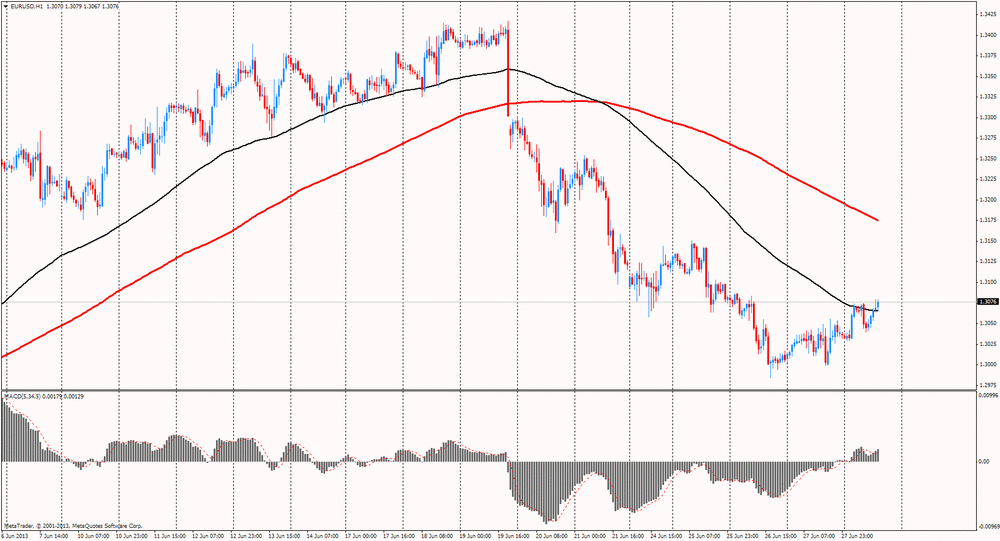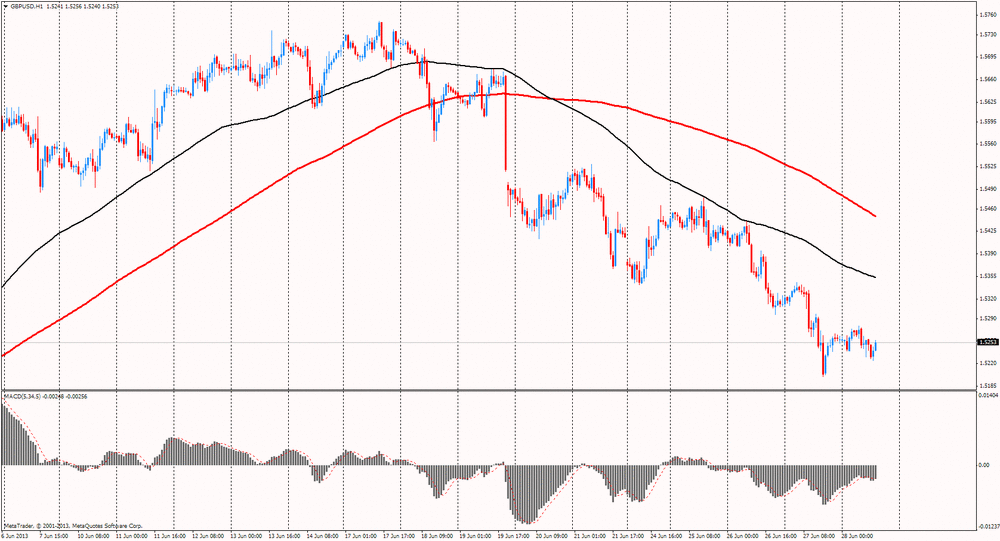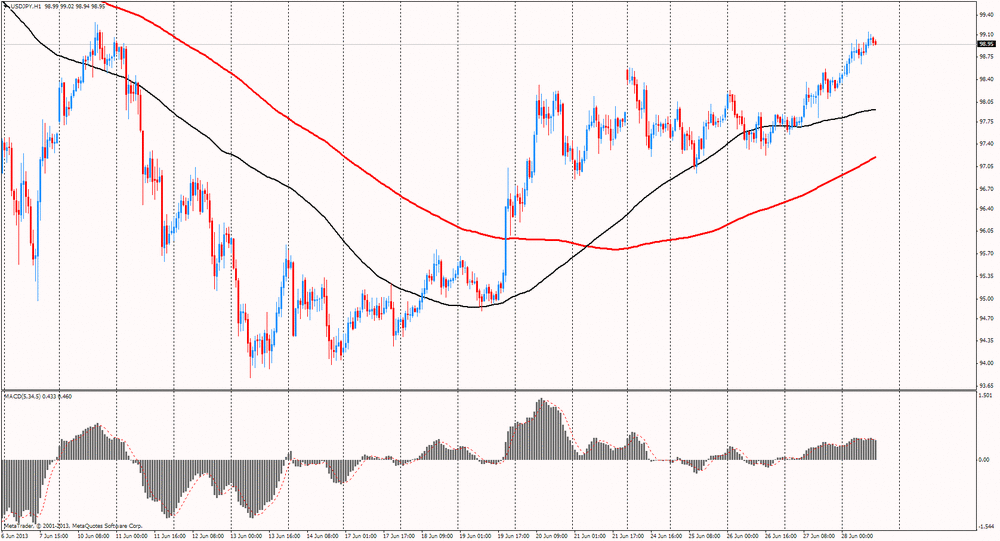Notícias do Mercado
-
19:19
American focus: The dollar rose
The dollar rallied against the majority of its most-traded counterparts as Federal Reserve Governor Jeremy Stein said the central bank may make a decision in September about tapering monetary stimulus.
The U.S. dollar rose against the Japanese yen and the euro after the publication of the index of consumer sentiment Michigansogo University / Reuters, the value of which turned out better than expected. According to the data, the final index of consumer sentiment rose in June to 84.1. Now the index is just below the nearly six-year high 84.5 reached in late May.
The U.S. dollar, despite the previously published data, which showed that manufacturing activity in the Chicago region slowed sharply in June. Adjusted for seasonal variations Purchasing Managers Index (PMI) of Chicago in June fell to 51.6 against 58.7 in the previous month. The index value was below the consensus estimate. A reading above 50 indicates expanding activity.
European currency earlier rose against the dollar after the EU leaders at their summit in Brussels to agree on the seven-year budget of the Community. All 27 EU member states supported the document, which has yet to be definitively approve the European Parliament.
Also boosted the euro helped the data for Germany, which showed that up to May, German retail sales were better than expected, as consumers returned to stores after being bypassed by their side because of the cold and rainy weather. According to the report, retail sales in May rose 0.8% in April, after three consecutive months of decline, exceeding economists' forecasts at 0.3%.
Value of the pound fell against the dollar, as the data from the Nationwide Agency showed that in June house prices in Britain rose again, showing at the same time increasing the fastest pace in more than two and a half years as mortgages have become more accessible and less expensive. According to the report, the monthly house price index rose in June by 0.3%, while the annual growth rate of 1.9%, which was the sharpest increase since September 2010. These achievements were below the 0.4% monthly rise and a 2.1% year-on-year increase that economists expected.
The Australian dollar fell and almost ready to fix your the biggest quarterly decline since 2008, ahead of a meeting of the Reserve Bank of Australia, which will take place on July 2. At the June meeting, the central bank left interest rates unchanged at 2.75%, confirming that "the current state of monetary policy continues to meet the situation." It has since been published many weak data, and analysts now expect the RBA will lower the interest rate by 25 basis points to 2.5%, and will also retain a bias towards further easing.
-
14:55
U.S.: Reuters/Michigan Consumer Sentiment Index, June 84.1 (forecast 83.1)
-
14:51
Option expiries for today's 1400GMT cut
EUR/USD $1.2950, $1.3000, $1.3100, $1.3200
USD/JPY Y97.00, Y97.75, Y98.00, Y98.50, Y98.90, Y99.00
EUR/JPY Y127.00, Y128.00
GBP/USD $1.5200, $1.5350
USD/CHF Chf0.9480
EUR/CHF Chf1.2250
AUD/USD $0.9150, $0.9200, $0.9225, $0.9375, $0.9400
-
14:45
U.S.: Chicago Purchasing Managers' Index , June 51.6 (forecast 55.2)
-
13:31
Canada: Industrial Product Prices, m/m, May 0.0% (forecast +0.7%)
-
13:31
Canada: GDP (m/m) , April +0.1% (forecast 0.0%)
-
13:31
Canada: Raw Material Price Index, May +0.2% (forecast +2.3%)
-
13:15
European session: Japanese yen continued its decline
Data
01:30 Australia Private Sector Credit, m/m May +0.3% +0.3% +0.3%
01:30 Australia Private Sector Credit, y/y May +3.1% +2.9% +3.1%
05:00 Japan Housing Starts, y/y May +5.8% +6.3% +14.5%
06:00 United Kingdom Nationwide house price index June +0.4% +0.4% +0.3%
06:00 United Kingdom Nationwide house price index, y/y June +1.1% +2.1% +1.9%
06:00 Germany Retail sales, real adjusted May -0.4% +0.4% +0.8%
06:00 Germany Retail sales, real unadjusted, y/y May +1.8% +0.2% +0.4%
06:45 France Consumer spending May -0.3% 0.0% +0.5%
06:45 France Consumer spending, y/y May +0.2% +0.3% +0.6%
07:00 Switzerland KOF Leading Indicator June 1.10 1.21 1.16
10:00 Eurozone EU Economic Summit
12:00 Germany CPI, m/m (Preliminary) June +0.4% 0.0% +0.1%
12:00 Germany CPI, y/y (Preliminary) June +1.5% +1.7% +1.9%
European currency rose against the dollar after the EU leaders at their summit in Brussels to agree on the seven-year budget for the community. All 27 EU member states supported the document, which has yet to be definitively approve the European Parliament.
Scheduled for 2014-2020. expenses of 960 billion euros mean a real reduction of the budget. Despite this, EU leaders agreed to speed up the allocation of resources to overcome youth unemployment. In particular, in the next two years, six billion euros will be earmarked for the creation of jobs, education and training for young people. The European Union is now almost a quarter of the population aged 18 to 25 years old are unemployed. In Greece and Spain, the situation is even more difficult - more than half of young people are unemployed.
We also add that the growth of the euro helped the data for Germany, which showed that up to May, German retail sales were better than expected, as consumers returned to stores after being bypassed by their side because of the cold and rainy weather.
According to the report, retail sales in May rose 0.8% in April, after three consecutive months of decline, exceeding economists' forecasts at 0.3%. The data came out, adjusted for inflation, and take into account calendar effects. It should be noted that sales growth is based on a robust labor market and the prospects for improving consumer confidence and household spending. Recall that the German unemployment fell in June to 12,000 in the month, seasonally adjusted, reducing unemployment to its lowest level since December 2012. The index of consumer sentiment, meanwhile, is close to a six-month high.
In addition, data released today showed that German retail sales in May rose with inflation at 0.4% per annum, as households buy food and drinks before the bank holiday. German retail sales in January-May increased by 0.2% per annum.
Value of the pound fell against the dollar, as the data from the Nationwide Agency showed that in June house prices in Britain rose again, showing at the same time increasing the fastest pace in more than two and a half years as mortgages have become more accessible and less expensive.
According to the report, the monthly house price index rose in June by 0.3%, while the annual growth rate of 1.9%, which was the sharpest increase since September 2010. These achievements were below the 0.4% monthly rise and a 2.1% year-on-year increase that economists expected.
Recall that in May, house prices rose by 0.4% compared to the previous month and 1.1% for the year.
"A number of factors may be responsible for the recent acceleration" - said Robert Gardner, listing the modest gains in employment, reduction of interest rates on mortgage loans as a result of the government scheme to finance lending, and improve the overall economy.
"At the same time, there are few signs that the supply of housing is improving significantly," said Gardner. The lack of new buildings are likely to keep prices elevated, while government programs to support lending to remain in place, the Organization for Economic Cooperation and Development and the International Monetary Fund said this in a recent assessment of the UK economy.
The Australian dollar fell and almost ready to fix your the biggest quarterly decline since 2008, ahead of a meeting of the Reserve Bank of Australia. Economists are reminded that the meeting will take place on July 2 RBA's monetary policy.
At the June meeting, the central bank left interest rates unchanged at 2.75%, confirming that "the current state of monetary policy continues to meet the situation." It has since been published many weak data, and analysts now expect the RBA will lower the interest rate by 25 basis points to 2.5%, and will also retain a bias towards further easing. Economists add that this year, the Central Bank will lower borrowing costs one more time (October or November) in view of the prospects of further weakening of the economy. Some experts argue that the recent political uncertainty and the upcoming elections increase the likelihood that in the near future, the Bank will not make any changes in the current course of monetary policy. Nomura economists write, "then how can we make the argument in the aspect of what the central bank does not want to be influenced by the developments on the political front, we believe that the RBA understands the need for additional stimulus at the moment, so the authorities are unlikely to wait three months and will support the economy as early as next week. "
The yen fell against all of its major counterparts amid rising stock markets in Asia, which reduces the demand for foreign exchange asylum. So Chinese stocks rose for the first time last eight days after the People's Bank of China pledged to maintain the stability of the money market in the region. Reducing the yen contributed to the published data on industrial production. The May figure increased by 2%, whereas in the previous month was an increase of only 0.9%. It is worth noting that economists had forecast a 0.2% rise
EUR / USD: during the European session, the pair rose to $ 1.3079
GBP / USD: during the European session, the pair fell to $ 1.5224
USD / JPY: during the European session, the pair rose to Y99.15
At 12:30 GMT Canada will report on changes in the volume of GDP for April, and will release an index of commodity prices for May. At 13:45 GMT the United States will present the Chicago PMI index for June, and 13:55 GMT - an indicator of consumer confidence from the University of Michigan in June.
-
13:01
Germany: CPI, y/y , June +1.9% (forecast +1.7%)
-
13:00
Germany: CPI, m/m, June +0.1% (forecast 0.0%)
-
12:45
Orders
EUR/USD
Offers $1.3175/80, $1.3160, $1.3151, $1.3100/10, $1.3076
Bids $1.3031, $1.3030-20, $1.3000, $1.2985/80, $1.2960/50
GBP/USD
Offers $1.5420/30, $1.5395/400, $1.5370/80, $1.5345/50, $1.5295/300, $1.5280
Bids $1.5231, $1.5220, $1.5201, $1.5193
AUD/USD
Offers $0.9395/00, $0.9370/75, $0.9345/50, $0.9330, $0.9295/00, $0.9285/90
Bids $0.9210/00, $0.9180, $0.9150, $0.9125, $0.9120
EUR/GBP
Offers stg0.8595/600, stg0.8591, stg0.8570/80, stg0.8569
Bids stg0.8520/15, stg0.8500, stg0.8465/60, stg0.8445/40, stg0.8420
EUR/JPY
Offers Y130.00, Y129.91, Y129.70, Y129.50, Y129.41
Bids Y128.85/80, Y128.55/50, Y128.20, Y128.00, Y127.50
USD/JPY
Offers Y100.20, Y100.00, Y99.80, Y99.45/50, Y99.25/30
Bids Y98.70/65, Y98.20, Y98.00, Y97.60/50
-
08:00
Switzerland: KOF Leading Indicator, June 1.16 (forecast 1.21)
-
07:46
France: Consumer spending , May +0.5% (forecast 0.0%)
-
07:23
Asian session: The yen fell
01:30 Australia Private Sector Credit, m/m May +0.3% +0.3% +0.3%
01:30 Australia Private Sector Credit, y/y May +3.1% +2.9% +3.1%
05:00 Japan Housing Starts, y/y May +5.8% +6.3% +14.5%
The yen fell against its 16 major peers, poised for a second weekly drop versus the dollar, as surging equity markets reduced demand for haven assets. Chinese stocks rose for the first time in eight days as People's Bank of China Governor Zhou Xiaochuan pledged money market stability. In Japan, consumer prices excluding fresh food were unchanged from a year earlier in May, the statistics bureau reported in Tokyo today, in line with analyst estimates. Industrial production increased 2 percent in May from the month before, when it rose 0.9 percent, according to preliminary figures from Japan's Ministry of Economy, Trade and Industry. Economists had forecast a 0.2 percent gain.
The U.S. currency climbed to a more than two-week high against the yen before data forecast to show consumer sentiment in the U.S. was stronger and business activity expanded this month. A report today is forecast to show U.S. consumer confidence was better than initially estimated in June. The Thomson Reuters/University of Michigan index of consumer sentiment was at 83 in June, compared with a prior reading of 82.7 for the month, according to the median estimate of economists in a Bloomberg News survey. The gauge would still be lower than the six-year high of 84.5 reached in May.
Australia's dollar fell, set for its biggest quarterly drop since 2008, before the Reserve Bank meets next week after saying it has scope to cut borrowing costs.
EUR / USD: during the Asian session the pair rose to $ 1.3075
GBP / USD: during the Asian session the pair rose to $ 1.5280
USD / JPY: during the Asian session the pair rose Y99.00
The US calendar starts at 1200GMT, when the first of the Fed speakers appears, As US Federal Reserve Gov. Jeremy Stein gives a speech on monetary policy to the Council on Foreign Relations in New York. At 1315GMT, Richmond Federal Reserve Bank President Jeffrey Lacker will deliver a speech on the economic outlook in White Sulphur Springs, West Virginia. Economic data sees the release of the June MNI Chicago Report at 1345GMT, followed by the June University of Michigan Consumer Sentiment report at 1355GMT. The MNI Chicago Report's business barometer is expected to fall back to a reading of 55.0 in June after surging to 58.7 in May, the highest reading since May 2012. The Michigan Sentiment index is expected to be revised up slightly to a reading of 83.0 in June from the 82.7 preliminary reading. There are two further Fed speakers to end the day. At 1600GMT, Cleveland Federal Reserve Bank Senior Vice President Mark Schweitzer will deliver a speech. Then, at 1930GMT, San Francisco Federal Reserve Bank President John Williams gives a speech on the economy in Rohnert Park, California.
-
07:03
Germany: Retail sales, real adjusted , May +0.8% (forecast +0.4%)
-
07:02
United Kingdom: Nationwide house price index, y/y, June +1.9% (forecast +2.1%)
-
07:02
United Kingdom: Nationwide house price index , June +0.3% (forecast +0.4%)
-
07:01
Germany: Retail sales, real unadjusted, y/y, May +0.4% (forecast +0.2%)
-
06:22
Currencies. Daily history for Jun 27'2013:
(pare/closed(00:00 GMT +02:00)/change, %)
EUR/USD $1,3036 +0,23%
GBP/USD $1,5257 -0,36%
USD/CHF Chf0,9450 +0,23%
USD/JPY Y98,43 +0,65%
EUR/JPY Y128,33 +0,91%
GBP/JPY Y150,17 +6,30%
AUD/USD $0,9282 +0,03%
NZD/USD $0,7797 +0,21%
USD/CAD C$1,0475 0,00%
-
06:02
Schedule for today, Friday, June 27’2013:
00:00 China Leading Index May 99.8
01:30 Australia Private Sector Credit, m/m May +0.3% +0.3%
01:30 Australia Private Sector Credit, y/y May +3.1% +2.9%
05:00 Japan Housing Starts, y/y May +5.8% +6.3%
06:00 United Kingdom Nationwide house price index June +0.4% +0.4%
06:00 United Kingdom Nationwide house price index, y/y June +1.1% +2.1%
06:00 Germany Retail sales, real adjusted May -0.4% +0.4%
06:00 Germany Retail sales, real unadjusted, y/y May +1.8% +0.2%
06:45 France Consumer spending May -0.3% 0.0%
06:45 France Consumer spending, y/y May +0.2% +0.3%
07:00 Switzerland KOF Leading Indicator June 1.10 1.21
10:00 Eurozone EU Economic Summit
12:00 Germany CPI, m/m June +0.4% 0.0%
12:00 Germany CPI, y/y June +1.5% +1.7%
12:00ьU.S. FOMC Member Jeremy Stein Speaks
12:30 Canada Industrial Product Prices, m/m May -0.8% +0.7%
12:30 Canada Raw Material Price Index May -2.2% +2.3%
12:30 Canada GDP (m/m) April +0.2% 0.0%
13:45 U.S. Chicago Purchasing Managers' Index June 58.7 55.2
13:55 U.S. Reuters/Michigan Consumer Sentiment Index June 82.7 83.1
-
06:00
Japan: Housing Starts, y/y, May +14.5 (forecast +6.3%)
-


